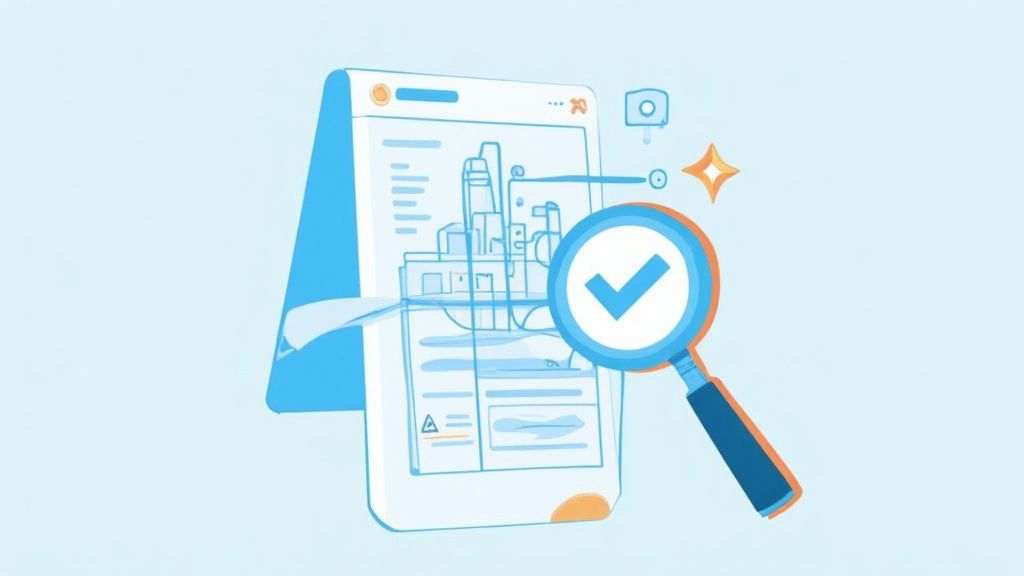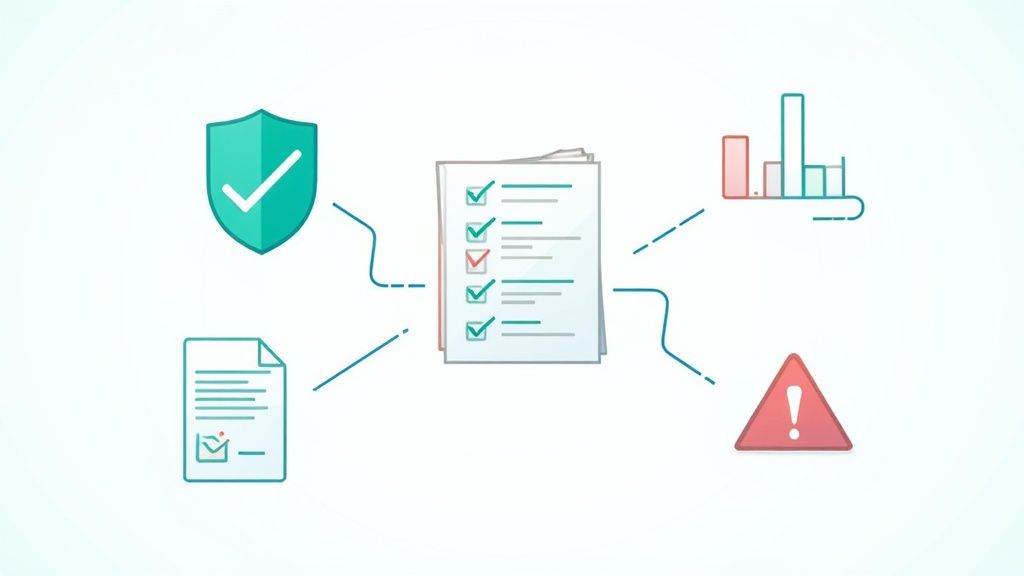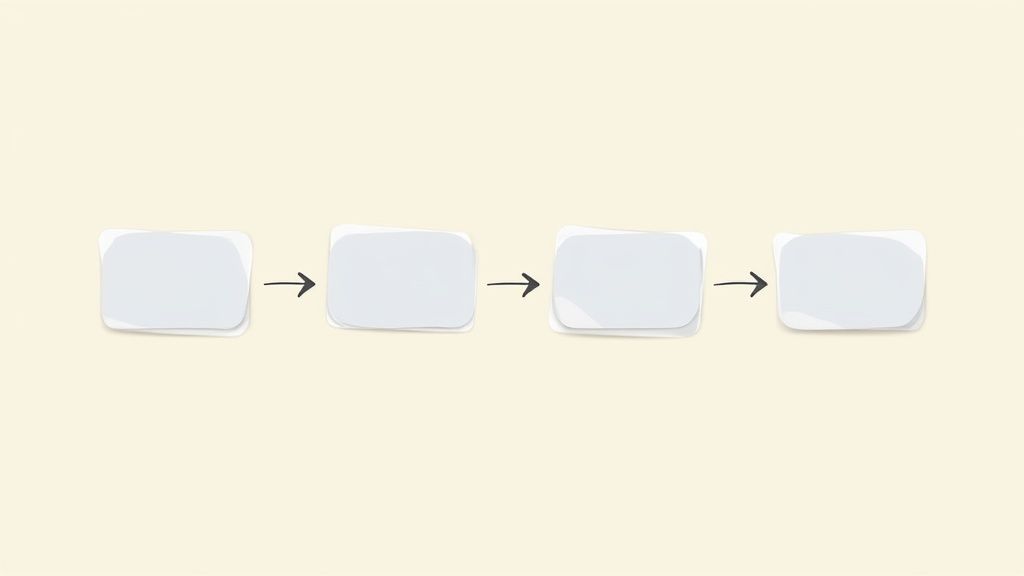So, what exactly is a supplier due diligence tool? Think of it as a sophisticated system that automatically handles the essential background checks on all your business partners. This isn't just a one-and-done check when you first sign a contract. It's about continuously keeping an eye on a supplier's financial health, legal status, and overall stability to make sure your business is safe from nasty surprises down the road.
Your Shield Against Supply Chain Chaos

Imagine your business is a high-performance car. Every single part needs to function perfectly for the engine to run at its peak. Now, what happens if a critical supplier—one of those essential parts—suddenly fails? Everything grinds to a halt. Orders stop, revenue dries up, and the reputation you've worked so hard to build takes a serious hit. A supplier due diligence tool is your shield against exactly this kind of chaos.
Don't think of it as just another software subscription. It's more like having a dedicated, automated investigator for every partner in your supply chain. It's your early warning system, flagging potential problems long before they can blow up.
You wouldn't buy a house without getting a full inspection to check for a cracked foundation or a leaky roof, right? A due diligence tool does the same for your business—it makes sure your suppliers are as solid and reliable as they appear on the surface.
This kind of proactive mindset is no longer optional. With supply chain disruptions becoming a regular part of doing business, waiting for a problem to surface is a surefire way to get into trouble. These tools give you the insight to act before a supplier's headache becomes your full-blown crisis.
Key Focus Areas for a Due Diligence Tool
A truly effective due diligence tool goes way beyond a simple credit check. It gives you a complete, 360-degree picture of your partner's stability by looking at several critical areas:
- Financial Health: Is the supplier financially sound? The tool digs into credit scores, payment patterns, and financial records to help you avoid partnering with a company teetering on the edge of bankruptcy.
- Legal & Compliance: It scans public records for lawsuits, regulatory fines, and other red flags. It also verifies that the supplier meets all necessary local and international laws, protecting you from getting caught in legal crossfire.
- Reputational Risk: The tool keeps an ear to the ground, monitoring news outlets and social media for negative press that could damage your own brand's reputation by association.
- Operational Capacity: Can they actually deliver what they promise? It helps confirm that a supplier has the right resources, quality control standards (like ISO certifications), and infrastructure to handle your needs reliably and consistently.
By automating what is otherwise a tedious and manual vetting process, a supplier due diligence tool frees up your team to focus on strategy. It turns a defensive chore into a real competitive advantage, helping you build a stronger, more resilient supply chain.
Why Manual Vetting Just Doesn't Cut It Anymore

Let's be honest. Relying on spreadsheets and manual checks to vet suppliers today is like trying to navigate a six-lane highway with a horse and buggy. It’s not just slow and outdated; it’s downright dangerous in the face of modern business risks.
The consequences of getting it wrong can be staggering. Imagine facing crippling fines because you unknowingly partnered with a supplier on an international sanctions list. Or picture your entire production line grinding to a halt because a key partner was financially unstable—a red flag buried deep in public records that no one had the time to uncover.
These aren't just hypotheticals; they're the everyday realities of today's global economy. Supply chains are more complex, regulations are far stricter, and the risk of fraud is higher than ever. Manual processes simply can’t keep up with the sheer volume and speed of it all.
From Putting Out Fires to Preventing Them
The old way of vetting suppliers was reactive. You essentially waited for a problem to pop up and then scrambled to fix the damage. In today's world, that’s a losing strategy. A modern supplier due diligence tool marks a critical shift toward being proactive, giving you the foresight to spot trouble long before it hits.
Waiting for a supplier to miss a delivery before you check their financial health is far too late. Discovering a compliance breach only after a regulator sends a notice is an incredibly expensive lesson to learn. A proactive approach means you’re identifying these red flags early on, when you can still do something about them.
This shift isn't just a trend; it's a massive market movement. The global vendor due diligence market is expected to rocket from around $5 billion in 2025 to nearly $12 billion by 2033. This growth is fueled by intense regulatory pressure and the absolute necessity for businesses to build resilient supply chains.
The Real-World Limits of Manual Checks
Manual verification is painfully slow, riddled with human error, and just doesn't go deep enough. It's practically impossible for a person to keep a constant eye on hundreds of suppliers, looking for new lawsuits, sudden credit score drops, or negative press.
Here are a few key areas where manual checks consistently fall short:
- Scale: Manually vetting a few suppliers is a chore. Vetting hundreds or thousands of them effectively? Forget about it.
- Depth: A quick Google search isn't going to uncover hidden ownership structures or check against global sanctions lists. Understanding the importance of conducting thorough background checks shows just how much detail is required.
- Continuity: Risk isn't a one-time event. A supplier who is perfectly safe today could become a major liability tomorrow. Manual checks are just a snapshot in time, whereas automated tools offer continuous, real-time monitoring.
Automating these checks isn't just about saving time; it's about business survival. It replaces administrative guesswork with data-driven confidence and frees your team to focus on strategy.
This is precisely why companies are ditching their cumbersome spreadsheets. They are turning to automated systems that do the heavy lifting, from verifying documents to flagging expirations. To see how this transformation works in practice, explore our guide on improving your document workflow automation. It’s how you turn due diligence from a dreaded task into a powerful strategic advantage.
Key Features of a Modern Due Diligence Tool

When you look at a dashboard like the one above, you're not just seeing data; you're seeing clarity. This is what a modern due diligence platform brings to the table—it takes you out of the weeds of spreadsheets and gives you a bird's-eye view of your entire supplier network. It’s about spotting trouble before it starts.
So, what should you actually look for in one of these tools? A good supplier due diligence tool isn't just a digital filing cabinet. It’s more like a command center for your supply chain, designed to give you a true 360-degree view of every partner you work with.
The best platforms don't just help you react to problems; they help you get ahead of them. They’re built for proactive risk management, turning due diligence from a box-ticking exercise into a real strategic advantage.
Real-Time Risk Monitoring and Alerts
One of the biggest game-changers is real-time risk monitoring. The world moves fast. A supplier that looked perfectly safe last quarter could be facing a major lawsuit or financial trouble today. Trying to keep up with manual checks is like trying to catch rain in a thimble—you’ll always miss something.
This is where a good tool shines. It continuously scans thousands of public and private data sources for red flags. You get an instant heads-up if a key supplier:
- Gets hit with a regulatory fine or lawsuit.
- Shows a sudden, sharp drop in their credit score.
- Pops up in negative news stories.
- Ends up on a global sanctions list.
This early warning system buys you time—precious time to pivot to another supplier or work with your current one to manage the risk before it blows up your operations.
AI-Powered Risk Scoring and Analysis
Let's be honest, nobody has the time to manually comb through financial reports, legal filings, and news articles for every single supplier. It's just not possible. This is where artificial intelligence (AI) becomes your best friend. AI-driven risk scoring chews through massive datasets to spot patterns and warning signs a human could easily miss.
Modern tools use AI to deliver dynamic risk scores, pulling information from everywhere—financial data, ESG reports, regulatory databases, and more. You can see how platforms like Kodiak Hub are using AI for this.
The result is a simple, color-coded risk score. Imagine seeing your suppliers flagged as "High Risk" in red, "Medium Risk" in yellow, or "Low Risk" in green. Right away, you know exactly where to focus your attention.
Centralized Document Management
Chasing down supplier contracts, insurance certificates, and compliance forms is a full-time job in itself. A core feature of any solid due diligence platform is a central place to keep all this documentation organized. But it’s not just about storage; it’s about smart management.
The system should automatically flag expiring documents and send reminders—to you and your supplier—to get updated versions. This means you’re never caught out with an expired insurance policy or an outdated certification. For businesses struggling with this, dedicated document collection software can be a lifesaver. Ultimately, this creates a single, auditable trail for every supplier, keeping everything clean and accessible.
The Critical Dimensions of Due Diligence

Think of proper due diligence as a full-body physical for a potential business partner. You wouldn't just take their temperature and call it a day, right? Of course not. You’d want to see every lab result and specialist's report to get a complete picture of their health before committing.
A robust supplier due diligence tool does the same thing for your business. It investigates a potential partner from every critical angle, piecing together different types of risk intelligence into one unified profile. It goes way beyond a simple credit check to make sure no stone is left unturned.
To truly understand a supplier, you need to look at them from several different angles. The table below breaks down the key areas that a comprehensive due diligence process should cover.
Key Areas of Supplier Due Diligence
| Diligence Type | What It Assesses | Example Risk Mitigated |
|---|---|---|
| Financial | The supplier's economic stability, cash flow, debt levels, and payment history. | Prevents partnering with a company on the brink of bankruptcy, which could halt your supply chain. |
| Legal & Compliance | Past and present lawsuits, regulatory fines, sanctions, and adherence to laws. | Avoids entanglement in a partner’s legal troubles or compliance failures that could bring fines. |
| Cybersecurity | The strength of their digital defenses, data protection policies, and breach history. | Protects your shared sensitive data from being exposed through a weakness in their systems. |
| Reputational | Public perception, negative media coverage, ethical scandals, and social media sentiment. | Guards your brand against damage by association with an unethical or controversial partner. |
| Operational | Their ability to deliver on promises, production capacity, quality control, and supply chain reliability. | Ensures the supplier can actually handle your workload and won't cause operational bottlenecks. |
Each of these areas provides a crucial piece of the puzzle, helping you build a complete risk profile before you sign a contract.
Financial and Legal Diligence
The first things most people think of are the financial and legal checks, and for good reason. They’re the bedrock of due diligence.
Financial diligence is all about confirming a supplier can keep the lights on. The right tool will dig into their cash flow, debt-to-income ratio, and payment history. The last thing you need is for a critical supplier to suddenly declare bankruptcy, leaving your entire operation high and dry.
At the same time, legal diligence is your corporate radar. It scans for lawsuits, regulatory penalties, and other legal red flags that could become your nightmare. A good guide to compliance risk management programs is invaluable for setting up the right internal frameworks to assess these risks effectively.
Cybersecurity and Reputational Diligence
In a world where everything is connected, a supplier's digital vulnerability is your vulnerability. Cybersecurity diligence is no longer optional; it’s essential. This process involves evaluating a partner’s security posture to make sure they can safeguard any sensitive data you share. A breach on their end can quickly become a full-blown crisis for you.
Finally, there's reputational diligence. This involves keeping an ear to the ground for negative press, public outcry, or ethical scandals tied to a supplier. If your key partner gets caught up in a controversy, the reputational splashback can hit your brand almost instantly.
A modern supplier due diligence tool pulls all of this information together into a single, easy-to-understand dashboard. Instead of trying to manage four or five separate investigations, you get one cohesive view of every potential risk. This lets you see the connections—how a legal problem might signal financial instability or how a bad reputation could point to deeper operational flaws—giving you the complete picture needed to make smart, safe decisions.
How to Choose the Right Due Diligence Tool
Picking the right supplier due diligence tool can feel a bit like trying to find the perfect key on a massive, jumbled keychain. With so many options out there, the trick is to focus on what fits your company’s unique lock. It all boils down to asking the right questions and looking past the flashy marketing to find a solution that genuinely supports how you operate.
Your first move should be to look inward. What are your biggest headaches right now? Are you drowning in compliance paperwork, losing sleep over the financial stability of your suppliers, or trying to get a handle on third-party cybersecurity risks? Your specific challenges will be the compass that points you toward the features you absolutely need.
Define Your Core Requirements
Before you even book a single demo, sit down and make a practical checklist of your non-negotiables. Think of this as your framework for judging each platform objectively. It’s what will keep you grounded and ensure you pick a tool that actually fits your industry, risk appetite, and day-to-day reality.
Start by asking these critical questions:
- Integration Power: How well will this tool play with your existing systems, like your procurement software or ERP? A tool that can't connect creates yet another data island, which just means more manual work for your team.
- Scalability: Can this solution grow with you? A tool that’s perfect for managing 50 suppliers might buckle under the pressure of 500. Make sure it can keep pace with your company's ambitions.
- User Experience: Is the interface genuinely intuitive, or does it feel like you’ll need a PhD to operate it? A powerful tool is useless if your team finds it too clunky to use. Adoption is everything.
Look Beyond the Surface
Once you’ve got your core requirements sorted, it’s time to dig into the quality and depth of the data. Honestly, this is where the real value of a tool is found. Don’t be shy about grilling vendors on where their information comes from and how frequently it’s updated. High-quality data is the engine that drives any effective due diligence process.
A supplier due diligence tool is only as good as the intelligence it provides. A sleek interface with outdated or unreliable data is like a fancy car with no engine—it looks good, but it won’t get you anywhere.
When you’re evaluating a tool, especially one that focuses heavily on environmental, social, and governance (ESG) factors, a specialized guide to choosing an ESG SaaS platform can be an incredibly helpful resource.
Finally, consider how the tool fits into your bigger picture. A great platform doesn’t just help you vet new suppliers; it simplifies the entire relationship, from the first handshake to ongoing performance monitoring. This connects directly to how you bring new partners into your ecosystem. For more on that, check out our guide on selecting the right vendor onboarding software.
By taking this structured approach, you can move forward with confidence and choose a tool that becomes a true strategic asset for your business.
Alright, let's get this section sounding like it was written by a seasoned procurement pro who's been around the block a few times.
Here is the rewritten section:
Getting the Most Bang for Your Buck: Putting Your Tool to Work
Buying the software is just the first step. The real win comes from weaving your new supplier due diligence tool into the very fabric of your procurement process, changing how your team fundamentally approaches risk. It’s about shifting from putting out fires to preventing them in the first place.
But let's be realistic—you can't just hand over the keys and hope for the best. A successful rollout is built on a solid foundation, empowering your team to use the tool with confidence.
Setting Your Ground Rules
First things first, you need to define what you care about. What specific events should set off alarm bells? Maybe it’s a supplier’s credit score taking a nosedive, a new lawsuit popping up, or a key executive suddenly leaving. By setting these triggers for automated alerts, you make sure your team focuses on genuine threats, not just a lot of noise.
Next, you have to create a clear playbook. When a financial red flag appears, who’s on it? What about a reputational risk? Figure out who owns what. A well-defined workflow means nothing gets missed and your team can jump on a problem quickly and in a coordinated way.
Think of your supplier due diligence tool less like a piece of software and more like a set of binoculars. It’s there to help your team see what’s coming over the horizon, giving you a chance to react before a small problem becomes a major disruption.
Making It Part of Your Team's DNA
The final piece of the puzzle is training. This is absolutely critical. Your team doesn't just need to know which buttons to click; they need to understand why it’s so important. The goal is to train them to think ahead—to connect a data point on a screen to what it could mean for your business in the real world.
When you take the time to do this right, your due diligence tool stops being just another software subscription. It becomes a core part of how you operate—making your business more resilient, more secure, and ultimately, more profitable.
Got Questions? We’ve Got Answers.
When you start digging into supplier risk, a few questions always pop up. Let's tackle the most common ones so you can see exactly how a supplier due diligence tool fits into the picture, no matter your company's size or budget.
How Much Does a Supplier Due Diligence Tool Cost?
There's no single price tag—the cost really depends on what you need. Think of it like a cell phone plan; you pay for what you use.
Most pricing models you'll run into are built to scale with your business. The two most common are:
- Pay-Per-Supplier: You're charged a fee for each supplier you're actively keeping an eye on. This is perfect if you want your costs to grow in lockstep with your supply chain.
- Tiered Packages: These are bundled plans offering different feature sets and supplier counts (e.g., for 50, 250, or 1,000+ suppliers). The higher you go, the more you get, like advanced analytics and deeper risk insights.
Of course, things like how much data you need, how many people on your team will use the tool, and any custom integrations will also play a role in the final cost.
Can a Small Business Actually Use These Tools?
Yes, and they absolutely should. In many ways, small businesses are the most vulnerable to supplier problems. They don't have the deep pockets or backup plans that larger corporations do. One key supplier failing can bring a small business to its knees.
The good news is that modern platforms are built for this. Many offer affordable, entry-level plans designed specifically for smaller companies.
It's not an enterprise-level luxury; it's essential insurance. For a small business, avoiding just one disastrous partnership can pay for the tool for years.
What’s the Difference Between Supplier Due Diligence and Vendor Risk Management?
Great question. It helps to think of them as two sides of the same coin—closely related, but with different jobs.
Supplier due diligence is the deep-dive investigation you do before you sign on the dotted line. It's that initial, intense background check to make sure a potential partner is legit, financially sound, and won't cause you compliance headaches down the road.
Vendor Risk Management (VRM), on the other hand, is the big-picture, ongoing process. It covers how you monitor and handle risks throughout your entire relationship with that supplier, from onboarding to offboarding. Due diligence is simply the critical first step in a solid VRM strategy.
Ready to stop chasing documents and start building a more resilient supply chain? Superdocu automates your supplier information collection, making due diligence simpler and more efficient. Discover how Superdocu can transform your onboarding process today.
